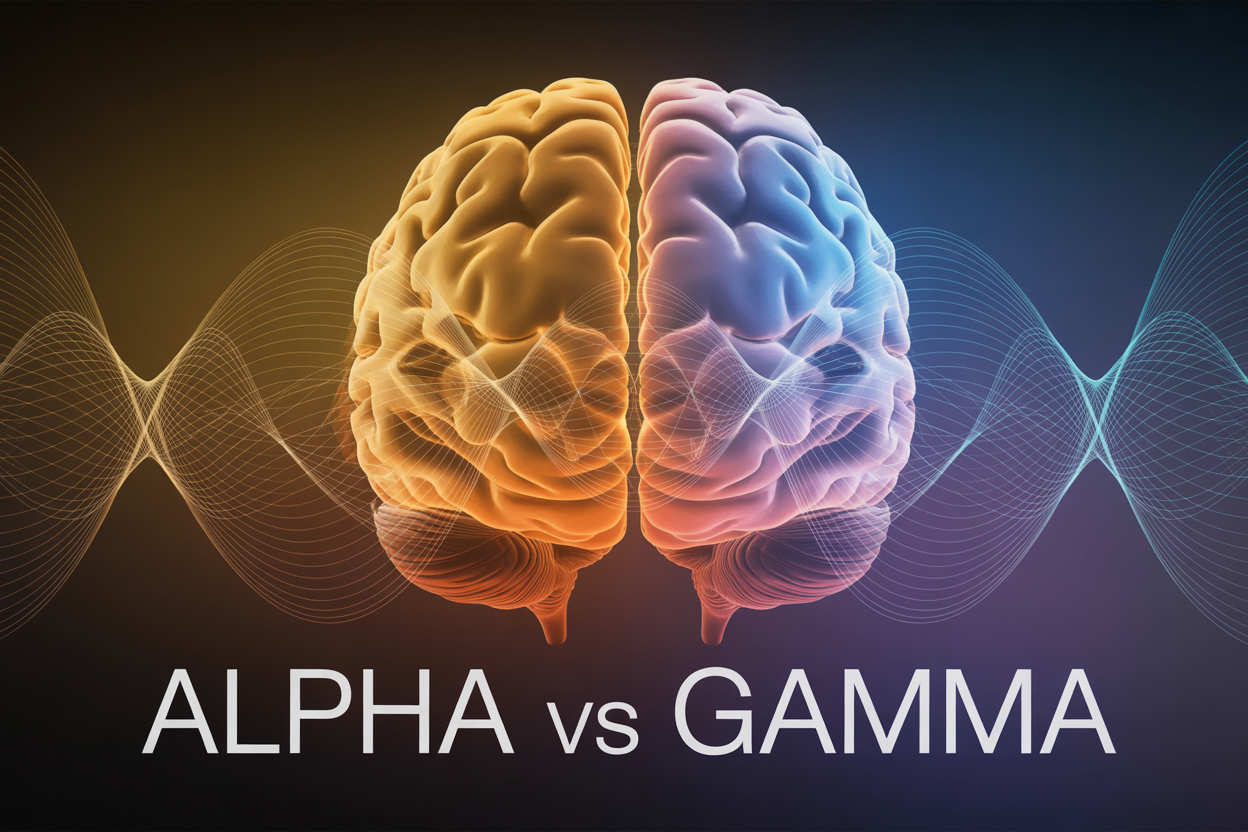How Advanced Meditators Hack Their Gamma Wave Activity for Peak Mental Performance
Experienced meditators and neuroscience enthusiasts have discovered something remarkable: specific meditation techniques can dramatically boost gamma wave activity in the brain. Gamma waves meditation isn’t just trendy science—it’s a measurable way to enhance focus, creativity, and cognitive performance that anyone can learn.
This guide is for meditators ready to go beyond basic practices, brain optimization enthusiasts, and anyone curious about the science behind meditation’s most powerful effects. You’ll discover the fascinating connection between meditation gamma brain waves and peak mental states, plus learn practical gamma wave meditation techniques used by advanced practitioners.
We’ll explore the neuroscience of how meditation rewires your brain to produce more gamma waves, reveal specific practices that boost gamma brainwave enhancement, and share actionable steps to develop your own gamma meditation practice. Get ready to unlock meditation’s most potent cognitive benefits.
Understanding Gamma Waves and Their Role in Peak Mental Performance

What gamma waves are and their frequency range
Gamma waves represent the fastest brainwave frequency, oscillating between 30-100 Hz, with the most significant activity typically occurring around 40 Hz. These high-frequency neural oscillations happen when large groups of neurons fire together in perfect synchrony, creating what neuroscientists call “neural binding.” Think of gamma waves as your brain’s way of connecting the dots between different regions, creating those moments of crystal-clear awareness and peak cognitive performance.
Unlike the slower brain waves you experience during sleep or relaxation, gamma waves meditation practitioners specifically target these rapid frequencies to unlock heightened states of consciousness. When your brain produces sustained gamma wave activity, it’s like having all cylinders firing simultaneously in a high-performance engine.
How gamma waves differ from other brainwave types
Each brainwave type serves a distinct purpose in your mental landscape. Here’s how gamma waves stack up against the competition:
| Brainwave Type | Frequency Range | Mental State | Function |
|---|---|---|---|
| Delta | 0.5-4 Hz | Deep sleep | Physical healing, regeneration |
| Theta | 4-8 Hz | Light sleep, meditation | Creativity, emotional processing |
| Alpha | 8-13 Hz | Relaxed awareness | Calm focus, stress reduction |
| Beta | 13-30 Hz | Normal waking | Logical thinking, problem-solving |
| Gamma | 30-100 Hz | Peak awareness | Integration, insight, transcendence |
Gamma waves stand apart because they don’t replace other brainwaves – they orchestrate them. While beta waves handle your everyday thinking and alpha waves create relaxed focus, gamma waves meditation techniques help synchronize all these frequencies into a coherent whole. This creates what researchers call “whole-brain coherence,” where different brain regions communicate with unprecedented efficiency.
The connection between gamma waves and heightened awareness
When gamma wave activity increases during meditation, practitioners report extraordinary experiences: time seems to slow down, awareness expands beyond the physical body, and insights emerge with startling clarity. These aren’t mystical claims – they’re the direct result of enhanced neural synchronization across your entire brain network.
Advanced meditation gamma waves create what neuroscientists term “expanded consciousness states.” During these moments, your prefrontal cortex, which handles executive functions, communicates seamlessly with your limbic system, responsible for emotions and memory. This integration allows meditators to observe their thoughts and emotions without getting caught up in them.
Long-term practitioners who regularly engage in gamma wave meditation techniques show permanent changes in their baseline brain activity. Their brains maintain higher gamma frequencies even during rest, suggesting that meditation literally rewires neural networks for sustained peak performance.
Why gamma wave activity indicates optimal brain function
Gamma brainwave enhancement serves as a reliable marker for optimal cognitive function because these frequencies only emerge when your brain operates at maximum efficiency. Research shows that people with naturally high gamma activity demonstrate superior working memory, enhanced attention span, and remarkable emotional regulation.
When you increase gamma waves through targeted meditation practices, you’re essentially training your brain to maintain its highest operational state. Studies of Olympic athletes and top performers across various fields reveal consistently elevated gamma activity during peak performance moments.
The most compelling evidence comes from studying meditation brain waves gamma frequency patterns in experienced practitioners. These individuals show gamma activity that’s 25-30 times stronger than control groups, correlating with reports of enhanced creativity, emotional resilience, and cognitive flexibility. This suggests that meditation peak performance gamma states aren’t just temporary experiences – they represent a trainable skill that fundamentally upgrades how your brain processes information and responds to challenges.
The Science Behind Meditation’s Impact on Gamma Wave Production

Research Findings on Long-term Meditators’ Brain Activity
Scientists have discovered remarkable differences in the brains of experienced meditators compared to non-meditators. Tibetan monks who’ve practiced meditation for over 10,000 hours show gamma wave activity that’s 700-800% higher than average during compassion meditation. These findings emerged from groundbreaking studies conducted at the University of Wisconsin, where researchers used advanced neuroimaging to peek inside the minds of meditation masters.
Long-term practitioners maintain elevated gamma brain waves even during rest states, suggesting their brains have fundamentally reorganized around heightened awareness. Dr. Richard Davidson’s team found that meditation gamma brain waves remain active between meditation sessions, creating a baseline of enhanced cognitive function that persists throughout daily activities.
The most striking discovery involves the synchronization of gamma waves across different brain regions. While most people show scattered, low-amplitude gamma activity, seasoned meditators display coordinated, high-amplitude waves spanning multiple neural networks simultaneously.
How Meditation Physically Rewires Neural Pathways
Regular gamma wave meditation techniques literally reshape brain architecture through neuroplasticity. The prefrontal cortex, responsible for executive function and attention regulation, shows increased thickness in practitioners who focus on advanced meditation gamma waves.
Meditation strengthens connections between the anterior cingulate cortex and the insula, creating more efficient neural highways for processing awareness and emotional regulation. These structural changes explain why experienced meditators can access peak performance gamma states more readily than beginners.
The default mode network, typically associated with mind-wandering and self-referential thinking, becomes less active during meditation practice. This neural shift allows practitioners to redirect mental energy toward gamma brainwave enhancement rather than getting caught in repetitive thought patterns.
White matter integrity also improves significantly, creating faster communication between brain regions. This enhanced connectivity supports the high-frequency oscillations characteristic of gamma meditation practice, enabling practitioners to maintain coherent awareness across complex mental tasks.
The Role of Focused Attention in Gamma Wave Enhancement
Sustained attention acts as the primary driver for meditation peak performance gamma activity. When practitioners maintain unwavering focus on a single object, breath, or mental state, their brains naturally shift into higher frequency patterns.
The attention networks in the brain work like a muscle – the more you exercise focused concentration during meditation brain waves gamma frequency training, the stronger these networks become. This explains why beginners struggle to maintain gamma activity while experienced practitioners can access these states almost instantly.
Different types of attention produce varying gamma wave patterns:
- Single-pointed focus: Creates narrow, intense gamma bursts
- Open awareness: Generates widespread, sustained gamma activity
- Loving-kindness meditation: Produces unique gamma signatures in emotional processing centers
The key breakthrough comes when attention becomes effortless. Advanced practitioners report that maintaining focus requires no mental strain – their brains have adapted to operate efficiently in gamma-dominant states.
Measuring Gamma Wave Changes Through EEG Studies
EEG technology provides real-time feedback on how to increase gamma waves during meditation sessions. Modern neurofeedback systems can detect gamma wave activity meditation within milliseconds, allowing practitioners to see immediate results from their efforts.
Researchers typically measure gamma activity in the 30-100 Hz frequency range, with the strongest meditation-induced changes occurring between 40-80 Hz. Baseline measurements taken before meditation show dramatic differences compared to readings during active practice.
| Meditation Type | Average Gamma Increase | Duration of Effect |
|---|---|---|
| Mindfulness | 25-40% | 2-4 hours |
| Compassion | 200-400% | 6-8 hours |
| Advanced Tantric | 600-800% | 12+ hours |
EEG studies reveal that gamma wave enhancement follows predictable patterns. Initial spikes occur within 60-90 seconds of beginning meditation, with peak activity typically reached after 8-12 minutes of sustained practice. The most experienced practitioners show gamma activity that remains elevated for hours after their meditation session ends, demonstrating the lasting neurological benefits of consistent gamma meditation practice.
Specific Meditation Techniques That Boost Gamma Wave Activity

Loving-kindness meditation for sustained gamma production
Loving-kindness meditation stands out as one of the most powerful gamma wave meditation techniques for creating long-lasting brainwave changes. This practice involves generating feelings of compassion and goodwill toward yourself and others, which researchers have found produces remarkable gamma wave activity meditation patterns.
The technique works by activating neural networks associated with positive emotions and empathy. Start by sitting comfortably and bringing to mind someone you care about deeply. Focus on sending them genuine wishes for happiness and well-being. Notice how this creates a warm, expansive feeling in your chest and throughout your body.
As you develop proficiency, extend these feelings to neutral people, difficult relationships, and eventually all living beings. Advanced practitioners report that this progression creates increasingly powerful gamma brainwave enhancement effects. The key lies in maintaining authentic emotional engagement rather than just reciting phrases mechanically.
Brain imaging studies show that experienced loving-kindness meditators maintain elevated gamma wave levels even outside meditation sessions. This suggests the practice creates lasting changes in how the brain processes emotions and social connections. The sustained nature of these gamma waves makes loving-kindness meditation particularly valuable for peak performance meditation applications.
Open monitoring meditation practices
Open monitoring represents a sophisticated approach to meditation gamma brain waves cultivation. Unlike concentration-based methods that focus on a single object, open monitoring involves maintaining awareness of whatever arises in consciousness without getting caught up in any particular experience.
This technique requires developing what researchers call “meta-cognitive awareness” – the ability to observe your thoughts, emotions, and sensations from a detached perspective. Begin by sitting quietly and simply noticing whatever enters your awareness. Don’t try to control or change anything; just observe with curious, non-judgmental attention.
The gamma wave meditation benefits emerge from this state of relaxed alertness. Your brain simultaneously processes multiple streams of information while maintaining a unified field of awareness. This creates the ideal conditions for gamma wave activity meditation to flourish naturally.
Research indicates that open monitoring practices produce different gamma patterns compared to focused attention techniques. The gamma waves appear more distributed across brain regions, suggesting enhanced integration between different cognitive networks. This makes open monitoring particularly effective for creative problem-solving and insight generation.
Concentration-based techniques that trigger gamma bursts
Concentration meditation offers the most direct path to generating intense gamma meditation practice effects through sustained focus on a single object. These techniques create what neuroscientists call “gamma bursts” – sudden spikes in high-frequency brain activity associated with moments of heightened awareness and understanding.
Single-pointed focus methods:
- Breath awareness: Focus intensely on the sensation of breathing at the nostrils
- Visual concentration: Maintain unwavering attention on a candle flame or geometric shape
- Mantra repetition: Repeat a sound or phrase with complete mental absorption
- Body scanning: Move attention systematically through different body regions
The secret to triggering gamma bursts lies in achieving what meditation traditions call “one-pointed concentration.” This state occurs when your attention becomes so stable and refined that the usual mental chatter completely subsides. At this moment, the brain often produces dramatic spikes in gamma activity.
Training for concentration requires patience and systematic practice. Start with shorter sessions of 10-15 minutes, gradually building your capacity for sustained attention. Many practitioners find that gamma wave enhancement occurs most reliably after 20-30 minutes of continuous focus, when the mind naturally settles into deeper states of absorption.
The intensity of these concentration-induced gamma bursts often correlates with breakthrough moments in meditation – sudden insights, feelings of unity, or profound states of clarity that can transform your understanding of consciousness itself.
Advanced Meditation Strategies Used by Experienced Practitioners

Combining Breathwork with Visualization for Enhanced Results
Seasoned meditators know that combining controlled breathing with vivid mental imagery creates a powerful synergy for gamma waves meditation. This dual approach engages multiple brain regions simultaneously, creating the perfect conditions for high-frequency brainwave production.
The 4-7-8 breathing pattern works exceptionally well when paired with golden light visualization. Breathe in for 4 counts while imagining brilliant light entering through your crown chakra, hold for 7 counts as you visualize this energy spreading throughout your brain, then exhale for 8 counts while seeing any mental fog dissolving. This technique consistently produces measurable increases in gamma wave activity meditation within just 10-15 minutes of practice.
Box breathing combined with geometric visualization takes this concept even further. Picture a rotating dodecahedron or complex mandala while maintaining steady 4-4-4-4 breath cycles. The brain’s attempt to process intricate visual patterns while coordinating breath control naturally shifts neural activity into gamma frequencies.
Using Mantras and Sound Frequencies to Amplify Gamma Waves
Sound-based meditation gamma brain waves enhancement relies on specific frequencies that naturally entrain the brain into gamma states. Advanced practitioners often use binaural beats in the 40-100 Hz range while chanting traditional mantras like “Om Mani Padme Hum” or “So Hum.”
The key lies in matching your vocal resonance with external sound frequencies. When you chant at approximately 40 Hz fundamental frequency while listening to gamma-inducing binaural beats, the brain experiences acoustic entrainment. This creates a feedback loop that amplifies natural gamma production.
Tibetan singing bowls tuned to specific pitches work remarkably well for advanced meditation gamma waves practices. Strike the bowl every 30 seconds during meditation while maintaining awareness of both the sound’s decay and your internal state. This intermittent acoustic stimulation keeps the nervous system in an optimal state for gamma wave generation.
Crystal bowl meditation takes this approach to another level. Different crystals produce distinct overtone patterns that can target specific brainwave frequencies. Clear quartz bowls typically generate harmonics in the gamma range, making them ideal tools for gamma brainwave enhancement.
Movement-Based Meditation Techniques for Gamma Activation
Static meditation isn’t the only path to gamma wave meditation techniques. Dynamic practices can be equally effective, especially for practitioners who find stillness challenging or want to integrate gamma states into active life.
Walking meditation with specific step patterns creates rhythmic neural entrainment. The most effective approach involves steps timed to 40 beats per minute while maintaining present-moment awareness. This natural pacing allows the brain to sync with gamma frequencies while the gentle movement prevents mental stagnation.
Qigong movements designed for mental clarity work exceptionally well for meditation peak performance gamma enhancement. The “Lifting the Sky” form, when performed with conscious breath control and focused intention, consistently produces gamma spikes in EEG readings. The key is maintaining smooth, flowing movements while directing attention to energy flow through the meridian system.
Tai chi practitioners often report peak experiences during the “Wave Hands Like Clouds” sequence. This particular movement pattern, when performed with meditative awareness, naturally induces gamma states through its complex coordination requirements and mindful attention demands.
Even simple finger mudras can generate gamma activity when combined with visualization. The Gyan mudra (thumb touching index finger) while visualizing energy circuits creates measurable increases in high-frequency brainwaves.
Time-of-Day Optimization for Maximum Gamma Wave Benefits
Circadian rhythms significantly impact how to increase gamma waves through meditation practice. Your brain’s natural gamma production follows predictable patterns throughout the day, and experienced practitioners learn to work with these cycles rather than against them.
Early morning sessions, particularly between 5-7 AM, often yield the strongest gamma meditation practice results. Cortisol levels peak during this window, creating ideal conditions for sustained high-frequency brainwave activity. The brain is naturally more receptive to gamma entrainment before the day’s mental clutter accumulates.
Pre-dawn meditation sessions tap into the brain’s natural reset period. During this time, the default mode network is less active, making it easier to access gamma states without fighting against habitual thought patterns.
Late afternoon sessions (4-6 PM) represent another optimal window for meditation brain waves gamma frequency enhancement. Body temperature peaks during this period, and alertness levels are naturally high without morning grogginess or evening fatigue interfering with practice.
Avoiding meditation within 2-3 hours of bedtime protects your natural sleep architecture. Gamma wave stimulation too close to sleep can interfere with the brain’s natural transition into slower wave states necessary for restorative rest.
Seasonal variations also matter. Winter months often require longer warm-up periods before accessing gamma states, while summer sessions may need additional cooling techniques to prevent overheating during intensive practice.
Practical Steps to Develop Your Own Gamma Wave Meditation Practice

Building a consistent daily meditation routine
Starting a gamma waves meditation practice requires dedication, but the rewards are extraordinary. Most practitioners see significant improvements in their gamma wave activity meditation within 4-6 weeks of consistent practice.
Begin with just 10-15 minutes daily, preferably at the same time each morning when your mind is naturally clear. This consistency trains your brain to anticipate and prepare for the deep states that generate gamma brainwave enhancement. As you develop comfort with basic meditation gamma brain waves techniques, gradually extend sessions to 20-30 minutes.
The key lies in treating your practice like a non-negotiable appointment with yourself. Set reminders, prepare your space the night before, and commit to showing up even when motivation wanes. Many advanced practitioners credit their breakthrough moments to maintaining practice during challenging periods.
Track your sessions in a simple journal, noting duration, technique used, and subjective experiences. This data becomes invaluable for identifying patterns and optimizing your gamma meditation practice.
Tracking your progress with biofeedback tools
Modern technology offers remarkable insights into your meditation peak performance gamma development. EEG headbands like Muse or NeuroSky provide real-time feedback on your brainwave states, showing exactly when you achieve the coveted 30-100 Hz gamma frequencies.
| Tool Type | Price Range | Key Features |
|---|---|---|
| Consumer EEG | $200-$400 | Real-time feedback, mobile apps |
| Professional EEG | $1000-$3000 | Detailed analysis, research-grade |
| HRV Monitors | $100-$300 | Heart rate variability tracking |
| Meditation Apps | Free-$15/month | Guided sessions, progress tracking |
Heart rate variability monitors also reveal valuable information about your autonomic nervous system’s response to advanced meditation gamma waves practices. When gamma activity increases, HRV typically improves, indicating better stress resilience and mental coherence.
Start with simpler tools before investing in expensive equipment. Many practitioners find that smartphone apps with basic meditation tracking provide sufficient feedback for developing their how to increase gamma waves skills.
Overcoming common obstacles in gamma wave development
Every practitioner encounters roadblocks in their gamma wave meditation techniques journey. Mental chatter, physical discomfort, and inconsistent results can frustrate even dedicated meditators.
Mental Resistance: Your brain naturally resists unfamiliar states. When thoughts become overwhelming during practice, acknowledge them without judgment and gently return focus to your chosen technique. This process actually strengthens the neural pathways associated with gamma production.
Physical Discomfort: Prolonged sitting can create tension that disrupts meditation brain waves gamma frequency development. Experiment with different postures, cushions, or even walking meditation to find what works best for your body.
Plateau Periods: Progress isn’t always linear. Weeks may pass without noticeable improvements in your gamma wave activity meditation. These plateaus often precede breakthrough moments. Trust the process and maintain consistent practice.
Expectation Management: Chasing specific experiences can actually inhibit gamma states. Approach each session with curiosity rather than rigid goals. The most profound gamma experiences often emerge when we least expect them.
Integrating gamma-boosting practices into daily activities
Gamma wave enhancement doesn’t require hours of formal meditation. Strategic integration throughout your day can dramatically accelerate development.
Micro-meditations: Take 2-3 minute breathing breaks between tasks. These brief moments of focused attention train your brain to access deeper states more readily during formal sessions.
Mindful Movement: Activities like yoga, tai chi, or even conscious walking can stimulate gamma production. The key is maintaining present-moment awareness while engaging in rhythmic, flowing movements.
Cognitive Challenges: Engaging in complex problem-solving, learning new skills, or creative activities naturally increases gamma waves meditation patterns. Musicians, artists, and mathematicians often display elevated gamma during their work.
Social Connection: Deep, empathetic conversations with others can trigger gamma states. Practice active listening and emotional presence during interactions to strengthen these neural pathways.
Creating the optimal environment for gamma wave meditation
Your physical environment significantly impacts your ability to achieve deep gamma states. Small adjustments can create dramatic improvements in your practice quality.
Temperature Control: Maintain a cool environment (65-70°F) to prevent drowsiness and support alertness. Many practitioners find that slightly cool air enhances their ability to sustain focused attention.
Lighting Considerations: Dim, warm lighting signals your nervous system to enter receptive states. Avoid harsh fluorescent lights or direct sunlight, which can overstimulate the visual cortex and interfere with gamma brainwave enhancement.
Sound Environment: While some prefer complete silence, others benefit from specific frequencies. Binaural beats in the 30-100 Hz range can help entrain your brain toward gamma states. Experiment with different approaches to discover your preference.
Sacred Space Creation: Designate a specific area exclusively for meditation. This physical anchor helps your brain recognize and prepare for deep states more quickly. Keep this space clean, uncluttered, and free from distractions.
The most important element is consistency in your chosen environment. Your brain learns to associate specific environmental cues with the deep states that produce optimal gamma wave activity meditation results.

Meditation isn’t just about sitting quietly and clearing your mind anymore. The science shows us that dedicated practitioners can actually rewire their brains to produce more gamma waves, those high-frequency brainwaves linked to heightened awareness, better focus, and peak mental performance. From understanding what gamma waves do in your brain to learning the specific breathing techniques and visualization methods that boost their production, we’ve covered the roadmap that separates casual meditators from those who’ve mastered their mental game.
The beauty of gamma wave meditation lies in its accessibility. You don’t need expensive equipment or years of training to start seeing results. Begin with just 10-15 minutes of focused attention meditation daily, gradually incorporating the advanced techniques like loving-kindness meditation and open awareness practices. Your brain’s ability to generate these powerful gamma frequencies will strengthen over time, leading to sharper thinking, better emotional regulation, and those breakthrough moments of clarity that experienced meditators talk about. Start small, stay consistent, and watch as your mind transforms into the high-performance tool you never knew you had.








